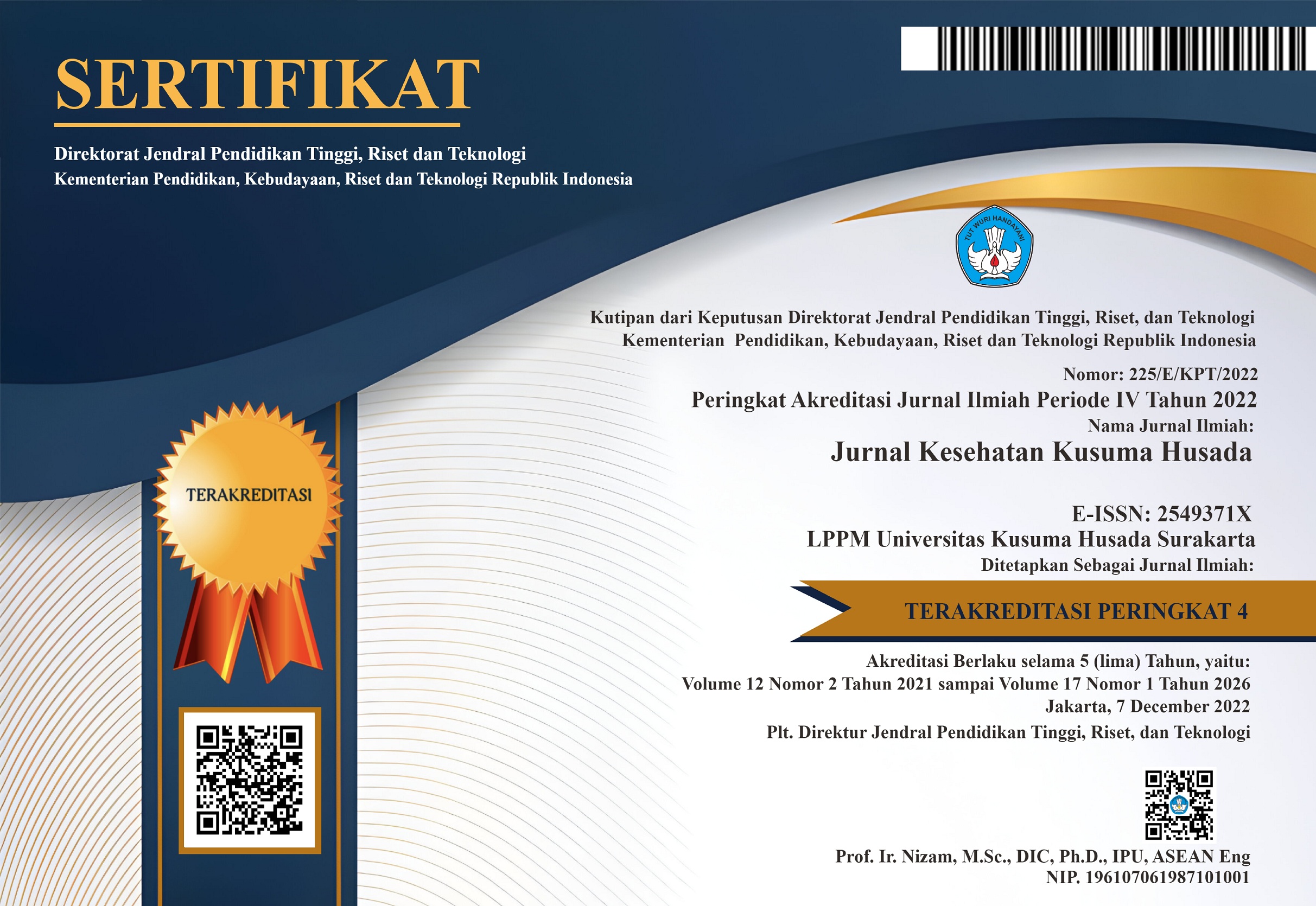PENGARUH KOMPRESI DADA BERDASARKAN RULE OF FIVE TERHADAP KEDALAMAN DAN FREKUENSI KOMPRESI DADA
Abstract
ABSTRAK
Kompresi dada rule of Þ ve yaitu kompresi dada menggunakan irama perhitungan dengan angka yang mempunyai 2 suku kata. Suku kata pertama digunakan sebagai kode waktu kompresi dan suku kata kedua sebagai kode waktu pengisian ventrikel. Irama perhitungan yang digunakan yaitu satu, dua, tiga, empat, satu, satu, dua, tiga, empat, dua, satu, dua, tiga, empat, tiga, satu, dua, tiga, empat, empat, satu, dua, tiga, empat, lima, satu, dua, tiga, empat, enam. Tujuan penelitian untuk menganalisis efek kompresi dada berdasarkan rule of Þ ve terhadap kedalaman dan frekuensi kompresi dada. Metode penelitian adalah Quasy Eksperiment dengan rancangan Pre-Post Test Randomized Control Group Design. Sampel dipilih berdasarkan kriteria inklusi memiliki IMT normal dan telah mengikuti pelatihan basic life support, dengan teknik simple random sampling dengan jumlah sampel 43 responden. Data yang diperoleh dianalisis menggunakan Mann-Withney U Test dengan tingkat kemaknaan 􀄮􀂔 0,05. Hasil penelitian menunjukkan bahwa tidak ada perbedaan yang signiÞ kan antara pre-test dan post-test pada kelompok kontrol dan kelompok eksperimen dengan hasil statistik Mann-Withney U Test P Kedalaman = 0,96 dan P Frekuensi = 0,597 (p = 0,05). Kompresi dada berdasarkan rule of Þ ve menghasilkan kedalaman kompresi 4-5cm, dengan kecepatan kompresi 100x/menit. Keteraturan irama kompresi menyebabkan tenaga penolong terjaga, sehingga kecepatan dan tekanan pijatan tetap konstan. Kesimpulan penelitian ini yaitu tidak ada efek kompresi dada berdasarkan rule of Þ ve terhadap kedalaman dan frekuensi kompresi dada.
Kata kunci: kompresi dada, rule of Þ ve, kedalaman,frekuensi, kompresi dada
ABSTRACT
Rule of Þ ve chest compression is chest compression using two word counting rhtym. The Þ rst word is used as a code when compressing and the second word as a code when Þ lling ventricle. Counting rhythm used is one, two, three, four,one, one, two, three, four, two, one, two, three, four, three, one, two, three, four, four, one, two, three, four, Þ ve, one, two, three, four,six. This research is aimed to anylize the effect of chest compression based on rule of Þ ve to the depth dan frequency of chest compression. The methode is a Quasy Experiment with Pre-Post Test Randomized Control Group Design. The sample chosen based on inclusion criteria normal IMT having a basic life training with simple random sampling with a number of 43 respondent. Data were analyzed using the Mann-Whitney U test with a signiÞ cance level of 􀄮 􀂔 0.05. The results showed that there was no signiÞ cant difference between pre-test and post-test in the control group and the experimental group with the statistical results of the Mann-Whitney U test P = 0.96 and P Depth Frequency = 0.597 (p = 0.05 ). Chest compression based on the rule of Þ ve produce 4-5cm depth of compression, with compression speed 100 X/menit. Rhythm regularity compression causes attendants maintained, so that the speed and the pressure remains constant massage. It is concluded that there is no effect of chest compression is based on the rule of Þ ve of the depth and frequency of chest compressions.
Keyword: chest compression, rule of Þ ve, depth, frequency, chest compression
The copyright of the published articles belongs to Jurnal Kesehatan Kusuma Husada.

This work is licensed under a Creative Commons Attribution 4.0 International License.











